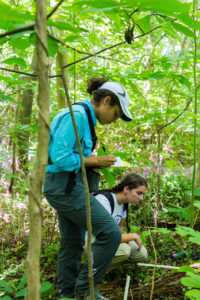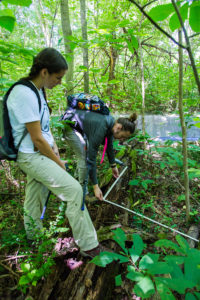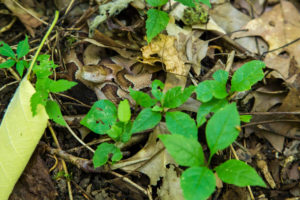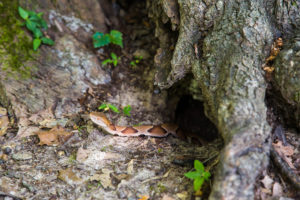Catching ’em all–copperheads, that is

While hundreds of park visitors converged on the Greensward in search of Pokémon, last week the Conservancy staff had an opportunity to see creatures that most park visitors will never encounter: copperhead snakes.
University of Memphis graduate researcher Malle Carrasco-Harris let us tag along as she checked in on several of the snakes she’s been studying for the last few years. Our summer forestry fellows from Rhodes College, Mac and Helen, even had the chance to operate the radio equipment that led us to the snakes, who have been microchipped at the Memphis Zoo and returned to their habitat. It’s no easy process to find a snake whose camouflage is so effective and whose movements are so minimal!
For this ongoing project under the advisement of U of M professor Dr. Judith Cole and Memphis Zoo Curator Dr. Steve Reichling, Malle is comparing copperhead populations at Overton Park and other locations, including Meeman Biological Field Station (north of Meeman-Shelby Forest State Park). Her goal is to understand the effect that urbanization has on snake populations. “It’s much easier to conduct that kind of research on birds,” she says, because birds are more visible and eye-catching, and they move around so much. Snakes present an opportunity to learn something new–and Overton Park is the perfect location.

The population of copperheads in the Old Forest has likely been isolated for more than a century. As Memphis became more and more developed, there was nowhere near the forest for the snakes to relocate. While birds and mammals can be quite mobile, it would take a snake a long time to move to another wooded habitat. A joyride through Lick Creek might take the snake somewhere else suitable to live, but it’s likely that there are few comings and goings.
Malle has caught dozens of snakes in the Old Forest and transported them to the Zoo for study. If they’re large enough, they receive a microchip so that Malle can locate them later. After taking basic data like size and weight, she returns them to the forest. When she locates them later, she finds that often they haven’t travelled far from their original location. Copperheads are far more active during their breeding seasons in early spring and late summer, when males are on the move in search of females.

One of the snakes Mac and Helen tracked down with the radio equipment was a gravid (pregnant) female. She had been previously captured and returned to the forest. The students took measurements of the area around the snake, the kind of cover she was using, and the canopy overhead. The snake watched silently, only moving her head occasionally to look at us. Malle hopes to locate her again after she has given birth. Copperheads don’t stay together for long after the young are born, so it’s a rare treat to see a family all at once.
So how does the Old Forest compare to Meeman-Shelby?
- Malle has trapped 73 copperheads at Overton Park and only three at Meeman Biological Station. However, the Meeman snakes are about four times larger than the Overton snakes.
- The Overton snakes are moving less than typical copperhead populations, with smaller “home ranges.”
- It’s much easier to find the snakes at Overton because of the easy access afforded by the Old Forest trail system. “Overton Park is such a gem in the city,” Malle says. “There’s not another place like it that has such easy trail access and so much continuous forest.” It’s an ideal place to conduct her research.

If reading all this makes you nervous, don’t worry–copperheads are not confrontational toward humans. They’re much more likely to shrink back into a cavity or hide under brush than to strike at a person. They prefer to use their camouflage to hide rather than aggressively defend their territory. If you ever do encounter a copperhead, just give the snake its space. The only time you’d be likely to step on one and trigger a defensive response is if you’re walking off-trail, which is just another great reason to keep to the paths…even if there’s a Pokémon in the distance!
Read more about the research project here. And to keep track of the project, follow Malle on Twitter at www.twitter.com/MemptileScience.



